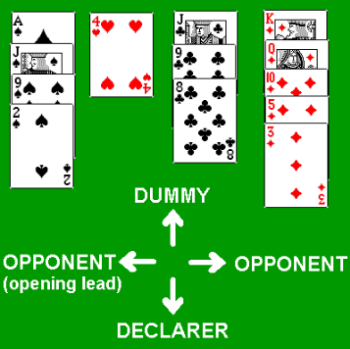
Introduction to playing a bridge hand
The basic concept of playing bridge
 After a successful auction, the person who mentioned the suit first has to play the contract. The "contract" is the highest bid that has been made during the auction and will be a number of tricks using one of the suits, (either clubs, diamonds, hearts or spades), as trumps or no trumps at all. The person playing the contract is known as the declarer. The declarer's partner is known as the dummy.
After a successful auction, the person who mentioned the suit first has to play the contract. The "contract" is the highest bid that has been made during the auction and will be a number of tricks using one of the suits, (either clubs, diamonds, hearts or spades), as trumps or no trumps at all. The person playing the contract is known as the declarer. The declarer's partner is known as the dummy.
The opening lead takes place by the player to the left of the declarer and then the dummy hand is exposed. The cards are played clockwise and the hand that takes the trick must lead to the next trick. The hand would look something like this. Don't worry about the values of the cards for now.
When describing bridge hands it is usual to use points of the compass to refer to where people are sitting. In practice, any position can be the declarer. In this picture the south hand is the declarer who must play the contract and s/he must play the cards both in their own hand and also in the dummy's hand, traditionally leaning over the table to do it: hence "Bridge". West and East become the defenders and they must act as a pair to try and defeat the contract. They are obviously not allowed to talk to each other during this process but they can make use of defensive techniques by giving signals with the cards they play.
Although the opening lead always comes from the hand to the left of the declarer, the lead for all the other tricks must come from the hand that takes the previous trick. This is vitally important and it means that if the declarer, for example, takes the trick in the dummy hand then the next lead must come from there. This can cause many headaches for inexperienced players.
Just like any whist based game, the highest of the four cards played takes the trick
